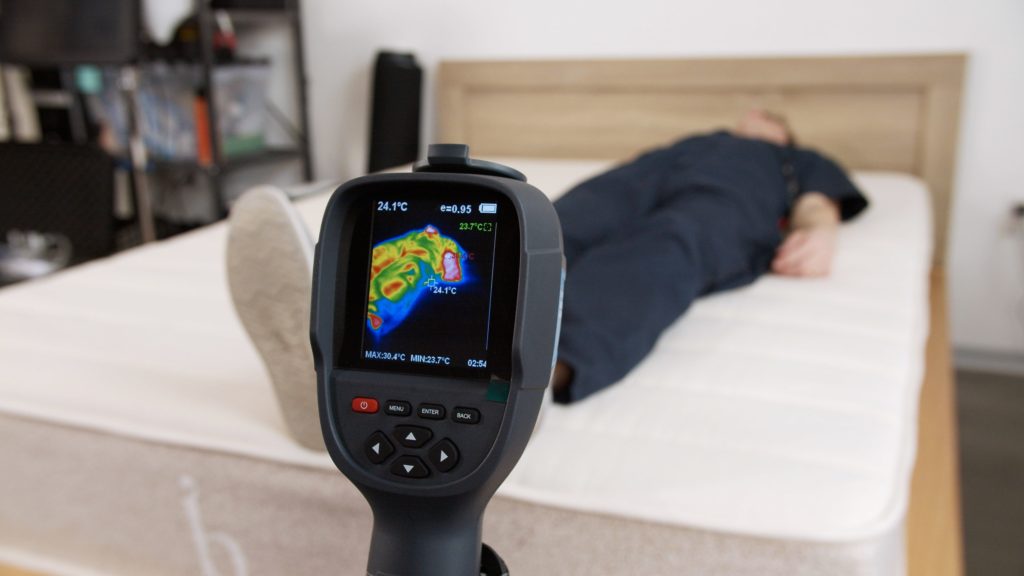Temperature Control
Overheating during the night often interrupts sleep and causes discomfort. Maintaining an appropriate temperature can not only improve the quality of your sleep but can also affect your sleep onset, sleep cycles, and sleep efficiency. While your room temperature, bedding, habits, and other factors also contribute, the mattress itself can be an essential component of temperature regulation.
In our Test Lab, located at our Seattle HQ, we monitor things like heat retention and air flow to rate the temperature control of top mattresses. On this page, we’ll explain the procedures and controls that we use to analyze a mattress’ temperature control capabilities. Additionally, we’ll break down what sleepers should know about temperature regulation and the role a mattress plays, including how specific materials affect its performance.
What Is Temperature Control?
When used as a performance criterion, temperature control refers to a mattress’ ability to regulate the surface temperature. Some materials are naturally prone to retaining warmth, which can effectively trap the sleeper’s body heat against them. More breathable components let air circulate in and out of the sleep surface, allowing heat to dissipate. A few materials are also designed to actively transfer heat away from the sleeper’s body to help them maintain a more neutral temperature.
Temperature control influences virtually every facet of the sleep experience. Excessive warmth may impact your sleep cycles and make it more difficult to fall asleep and stay asleep. The right sleep temperature is also critical to overall comfort.
Who Should Care About Temperature Control?
A mattress with strong temperature control is a valuable asset for individuals who live in warm climates and those prone to sleeping hot. Both groups often need to leverage every benefit they can to combat unwanted heat retention, reduce sweating, and enhance overall comfort.
By contrast, sleepers who tend to get cold during the night might not prioritize temperature control. If your room tends to feel too cool and you frequently pile on blankets, a mattress that retains warmth might be a more comfortable option.
Mattress Materials and Temperature Control
While some beds include unique cooling or heating features, the materials inside the mattress can play an important role in temperature regulation. At the Test Lab, we measure how much heat a mattress retains for an extended period of time.
Temperature control is mainly affected by the mattress’ breathability and contouring, both of which depend on its materials and construction. If a mattress has open areas that air can permeate, then cooler air can enter and relieve heat buildup. Less contouring also promotes greater air circulation around the body, thereby letting heat dissipate.
Since the mattress’ comfort system rests closest to the sleeper’s body, its materials are particularly influential in determining temperature control. We’ll explain the general traits of some commonly used materials, though performance may vary depending on the formulation, firmness, and overall construction of the mattress.
| Material | Description | Feel | Temperature Control Performance |
|---|---|---|---|
| Memory Foam | Memory foam is viscoelastic foam that molds to the body in response to its weight and warmth. | Since it conforms closely and responds slowly to changes in pressure, memory foam generally provides the sensation of sleeping in, rather than on, the bed. This is usually beneficial for pressure relief, but it can impede movement. | Traditional memory tends to retain heat and trap it against the body. This effect is amplified by the material’s tendency to conform closely, leaving little room for heat to escape. Some newer formulations use an open-cell structure or infusions of gel, graphite, or copper intended to disperse excess warmth. |
| Polyfoam | Polyfoam is another term for polyurethane foam, which is a synthetic material that adjusts to the sleeper’s shape by responding to pressure. | Polyfoam cushions and contours without a lot of hug, giving it a more responsive feel than memory foam while still easing pressure points. This material is quite versatile and can take on different properties depending on how it is made. | Polyfoam generally has better air circulation than traditional memory foam. This effect is further enhanced by polyfoam’s gentler contouring, which allows more airflow around the body. |
| Latex | Most latex mattresses use natural latex derived from the sap of rubber trees, but some use synthetic or blended alternatives. Latex can be processed using the Dunlop method, which yields a denser material; or the Talalay method, which retains more air bubbles for a buoyant, springy feel. | While sleepers frequently liken the feel of memory foam to sleeping in the bed, latex is more akin to sleeping on it. The material spreads the sleeper’s weight over a relatively wide area, which relieves pressure, limits sinkage, and gives the surface a responsive feel. | Not only is latex relatively breathable, but it is also often ventilated with small perforations for additional airflow. Furthermore, latex doesn’t hug closely to the body, so heat generally dissipates quickly and easily. Talalay latex usually offers better temperature neutrality than Dunlop latex due to its airier composition. |
| Microcoils | Microcoils are small metal springs, typically measuring 1 to 3 inches in height. They are most commonly used in the comfort and transition layers of hybrid mattresses. | Microcoils add bounce and support, but their small size also allows them to compress easily enough to relieve pressure. This combination lends a balanced, cradling sensation. | Air can filter through coil systems virtually unimpeded, so microcoils typically enhance a mattress’ temperature regulation. |
Temperature Control by Mattress Type
Due to differences in airflow, certain mattress types tend to perform better than others at temperature neutrality. We’ll go over what you can generally expect from the most common mattress types, but keep in mind that performance traits may vary from one mattress to another based on their unique designs and materials.
Innerspring: Innerspring mattresses consist primarily of a coil system, though they may also have a thin comfort layer. Since air can circulate between the coils, innerspring models usually excel at temperature regulation.
Hybrid: Hybrid mattresses pair a coil core with a comfort system of memory foam, polyfoam, latex, microcoils, or other materials. Despite the added contouring of their thicker comfort systems, hybrid models usually earn high marks in temperature control thanks to their breathable support cores.
Latex: Latex mattresses may use natural, synthetic, or blended latex, all of which typically have open-cell structures that promote heat dispersal. Additionally, latex often has perforations for additional airflow, and its limited sinkage reduces the likelihood that the mattress will trap the sleeper’s warmth against their body.
All-Foam: While some all-foam models regulate temperature exceptionally well, this mattress type is typically the most prone to heat retention. All-foam models generally use high-density polyfoam cores that allow minimal air circulation. Memory foam mattresses frequently conform quite closely, limiting airflow around the sleeper.
Airbed: Airbeds tend to stay more or less at room temperature because the air in their chambered support systems naturally adjusts to the ambient conditions. This can have a cooling effect. However, many airbeds have ample comfort systems that could trap heat.
While the type of mattress matters, its comfort system and firmness level can be just as important to consider when assessing temperature control. Even if the mattress has a breathable core, a thick comfort layer of a material that tends to trap warmth could make the bed sleep hotter than others with similar support systems. Similarly, mattress types prone to heat retention may effectively counteract this tendency through specialty materials, layering techniques, or increased firmness.
How Do We Test for Temperature Control?
Our testing system includes both quantitative and qualitative measures, designed to gather objective data as well as subjective perceptions about a mattress’ temperature neutrality.
To reduce the potential for bias shaping our data, we implement consistent controls for our temperature regulation tests:
- We reinforce the base of the bed to limit movement.
- We monitor the room’s temperature using a wall thermometer and endeavor to maintain a consistent temperature regardless of the season.
- We measure the temperature of the mattress surface before conducting tests.
Mattresses that earn low scores in our tests are those that absorb and retain warmth even after the heat source is removed. Those that perform well maintain a more neutral temperature by allowing heat to dissipate.

Temperature Test
Our temperature tests aim to collect an objective reading of a mattress’ heat absorption. To replicate normal human body temperature, we heat water to 98.6 degrees using a temperature-controlled kettle and place it in a hot water bottle.


We then put the hot water bottle in a designated position in the center of the mattress and leave it for 15 minutes. Upon removing it, we measure the temperature of the bed directly under the bottle as well as the surrounding area. In addition, our testing team uses a thermal camera and laser thermometer technologies to monitor surface temperature changes and assess overall heat retention. Once the team has collected temperature readings, they also touch the bed to feel for warmth.
For consistency across tests, we use the same kettle to heat the water and we fill the hot water bottle right before the test. We also use a consistent amount of water for each evaluation, and we place the bottle in the same position on each mattress.
Body Testing – Body Contouring and Airflow
After testing the mattress with a hot water bottle, our testers lie on the bed in different positions to evaluate contouring, air circulation, and heat buildup around the body.
To assess heat retention, each tester lies on their back for 5 minutes, then on their side for 5 minutes, and finally on their stomach for 5 minutes. After each position, the tester notes the levels of contouring and airflow as well as their overall impressions. We also record the temperature of the sleep surface after each 5-minute interval.
We implement consistent standards to control for variables that could influence test results. Between each positional test, we give the bed time to return to its normal state, and we record its temperature before a tester lies down. Our team of body testers includes individuals with different body types, and the same testers lie in the same spot on each model.
Learn more about the Test Lab at the link below.

Frequently Asked Questions About Temperature Control
Can I improve my bed’s temperature control?
Sleepers can adjust their bedding and sleep accessories to better regulate the temperature of their existing sleep surface.
Lightweight, breathable sheets are a simple solution to trap less heat. Certain materials, like cotton, linen, and rayon, usually allow significant air circulation. Similarly, sheets with a percale weave are generally popular with hot sleepers for their crisp, lightweight feel.
You might also consider a mattress topper designed for cooling. If the comfort system of your mattress is prone to heat retention, adding an extra layer may make a difference. Toppers that use more breathable materials, such as open-cell or ventilated foam, provide extra space for air to circulate close to your body. Some toppers also include features engineered for cooling, such as infusions of gel, copper, graphite, or phase change material.
For those who want even more control over the temperature of their sleep surface, a heating and cooling mattress pad can be a convenient solution. These devices enable a sleeper to select their preferred temperature. Some models also allow sleepers to adjust the temperature of each side separately, which may be ideal for couples with different preferences.
Additionally, other sleep accessories, such as a cooling pillow or breathable sleepwear, may be effective.
What type of mattress is best for temperature control?
Hybrid and innerspring mattresses are usually among the top performers in temperature regulation, due to airflow through their coil layers. Latex models and airbeds also frequently excel in this category.
Some all-foam models perform well, especially if they’re designed for breathability and temperature control. However, beds with comfort layers of close-conforming traditional memory foam are often prone to retaining excess warmth, regardless of whether they use an all-foam or a hybrid design.
What other ways can I keep cool during the night?
Modifications to your room and lifestyle can help you stay cooler at night.
It may be beneficial to lower the temperature of your thermostat, use a fan, or turn on air conditioning. During warm weather, thermal curtains can further help control the room temperature.
Lifestyle modifications may also be beneficial for some sleepers. Consuming caffeine and alcohol can cause fluctuations in body temperature that could make you uncomfortable during the night. Some people also find that eating heavy meals or engaging in high-intensity exercise before bed makes it difficult to cool down. Changes to your diet and exercise schedule may be worth exploring if you struggle to maintain a suitable temperature for sleep.

